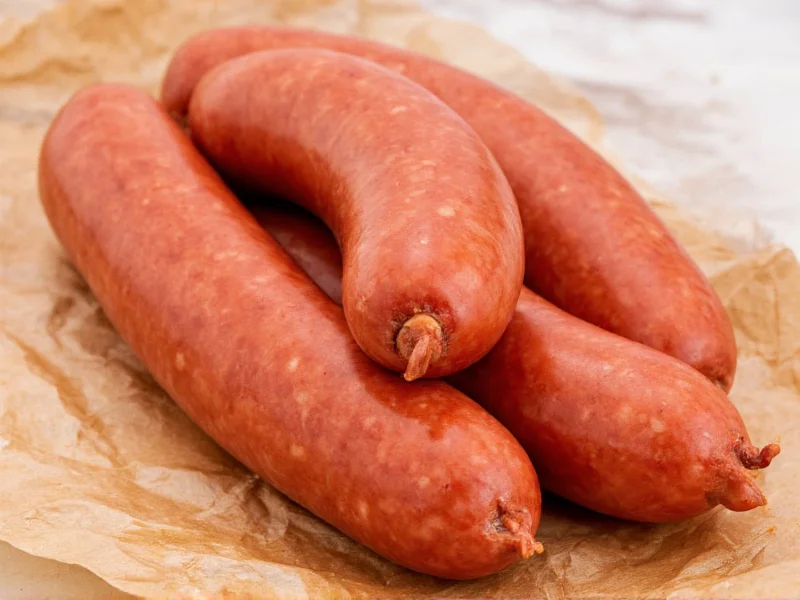When encountering the word andouille for the first time, many people struggle with its pronunciation. This specialty sausage has become increasingly popular beyond its traditional Louisiana roots, making proper pronunciation valuable for home cooks, restaurant patrons, and food enthusiasts alike.
Phonetic Breakdown of Andouille Sausage Pronunciation
Let's break down the pronunciation of "andouille" syllable by syllable:
| Syllable | Phonetic Spelling | Description |
|---|---|---|
| an | ahn | Similar to "on" but with a more open nasal sound, like the "an" in "France" |
| douil | DOO | Emphasized syllable, pronounced like "doo" in "doodle" |
| le | ee or yuh | Soft ending, either like "ee" in "see" or a softer "yuh" sound |
When saying the full term "andouille sausage," the emphasis remains on the "DOO" syllable: ahn-DOO-ee sausage.
Origin of Andouille and Its Pronunciation
Andouille (pronounced ahn-DOO-ee) has French origins, specifically from the Brittany and Normandy regions. The word derives from the Latin "inductilis," meaning "intestine," which makes sense given that traditional andouille is made from pork intestines.
When French settlers brought this sausage to Louisiana, it evolved into the spicier version we know today in Cajun cuisine. Despite this American adaptation, the pronunciation has remained closer to the original French than many other loanwords in English.
What Is Andouille Sausage?
Andouille sausage is a coarse-grained smoked sausage made with pork, garlic, pepper, onions, wine, and various seasonings. Unlike many sausages, authentic Cajun andouille is typically pre-cooked, which means it's often used to flavor dishes rather than served as the main protein.
It's a staple ingredient in traditional Louisiana dishes such as:
- Gumbo
- Jambalaya
- Red beans and rice
- Étouffée
Common Mispronunciations to Avoid
When learning how to say andouille sausage correctly, be mindful of these common mispronunciations:
- an-DOO-ee-eye - Adding an extra syllable at the end
- an-DUH-ee - Making the second syllable too soft
- AN-doo-ee - Emphasizing the wrong syllable
- an-DOO-ill - Trying to pronounce the "-ille" as in English "ville"
- an-DOO-ee-ul - Adding a French "l" sound that doesn't exist in the word
Remember that in French pronunciation, the "-ille" ending typically makes a "y" sound, similar to the "ll" in "million."
Andouille vs. Andouillettes
Don't confuse andouille with andouillettes, which are a different French sausage. While andouille (ahn-DOO-ee) is the smoked sausage used in Cajun cooking, andouillettes (ahn-doo-ee-ET) are grilled sausages made from chitterlings (pork intestines). The pronunciation differs mainly in the final syllable, with andouillettes having an additional "et" sound at the end.
Using Andouille Sausage in Conversation
Now that you know how to pronounce andouille sausage correctly, here are some examples of how to use it in conversation:
- "I picked up some ahn-DOO-ee sausage for the gumbo recipe."
- "The authentic flavor comes from the ahn-DOO-yuh in the dish."
- "Would you like to try this Cajun ahn-DOO-ee?"
Using the correct pronunciation shows culinary knowledge and respect for the cultural origins of this traditional ingredient.
Regional Variations in Pronunciation
While "ahn-DOO-ee" represents the standard pronunciation, you might hear slight variations depending on region:
- Louisiana/Cajun regions: Often softened to "ahn-DOO-yuh" with a more subtle ending
- Formal culinary settings: More precise "ahn-DOO-ee" pronunciation
- French-speaking regions: The "L" at the end is virtually silent, making it closer to "ahn-DOO-ee"
These subtle differences don't change the fundamental ahn-DOO-ee pronunciation pattern.
Mastering Culinary Terminology
Learning the correct pronunciation of specialty food terms like andouille sausage pronunciation demonstrates culinary literacy. As global cuisines become more accessible, knowing how to properly say ingredient names enhances your cooking experience and communication with others in kitchen settings.
When in doubt about pronunciation of any culinary term, remember that many French-derived food words maintain elements of their original pronunciation even when adopted into English usage.
How do you pronounce andouille sausage in French?
In French, andouille is pronounced "ahn-DOO-ee" with a slightly more nasal "ahn" sound and the final "-ille" making a soft "y" sound. The French pronunciation is closer to "ɑ̃.duj" in IPA (International Phonetic Alphabet), with the "j" representing the "y" sound.
Is it correct to say 'andouille' as 'an-doo-ee' or 'an-doo-ill'?
The correct pronunciation is 'ahn-DOO-ee' or 'ahn-DOO-yuh.' 'An-doo-ill' is incorrect as the '-ille' ending in French makes a 'y' sound, not an 'ill' sound like in English. The first syllable should have a nasal 'ahn' sound rather than a clear 'an' as in English.
What's the difference between andouille and andouillette pronunciation?
Andouille (ahn-DOO-ee) has three syllables with emphasis on the second syllable, while andouillette (ahn-doo-ee-ET) has four syllables with the emphasis on the final 'ET' syllable. The key difference is that andouillette has an additional syllable at the end pronounced like 'et' in French.
Why is andouille sausage pronounced differently from how it's spelled?
Andouille sausage pronunciation follows French phonetic rules rather than English spelling conventions. In French, 'ou' makes a 'oo' sound, and '-ille' at the end of words typically creates a 'y' sound. Many culinary terms borrowed from French maintain their original pronunciation patterns even when adopted into English.
How can I remember the correct pronunciation of andouille sausage?
Try this memory aid: 'Ah, DOO like to eat that sausage!' The emphasis falls naturally on 'DOO,' helping you remember the correct stress pattern. Another trick is to break it into 'ahn-DOO-ee' and practice saying it slowly at first, then gradually speeding up to a natural pace.











 浙公网安备
33010002000092号
浙公网安备
33010002000092号 浙B2-20120091-4
浙B2-20120091-4